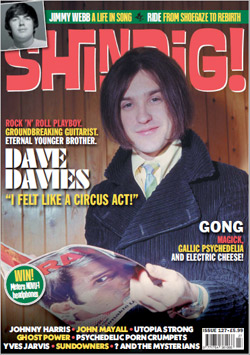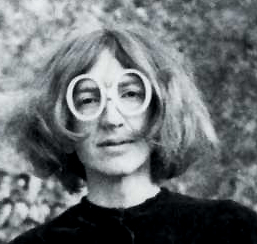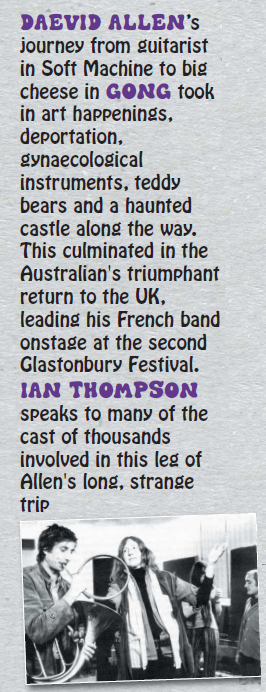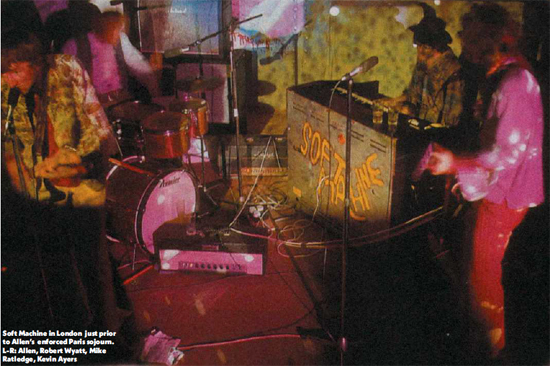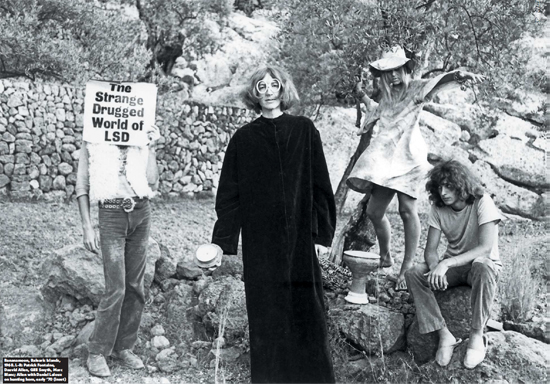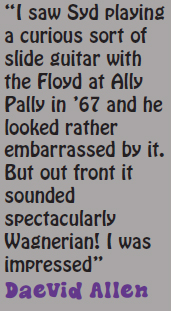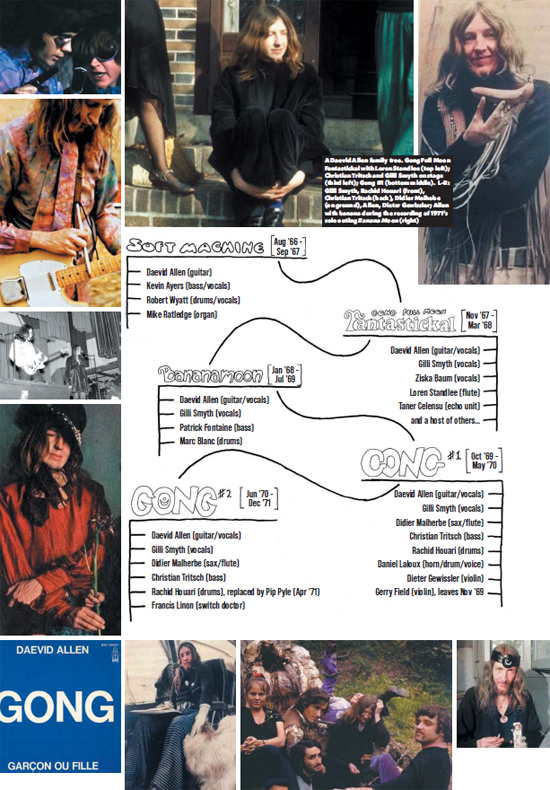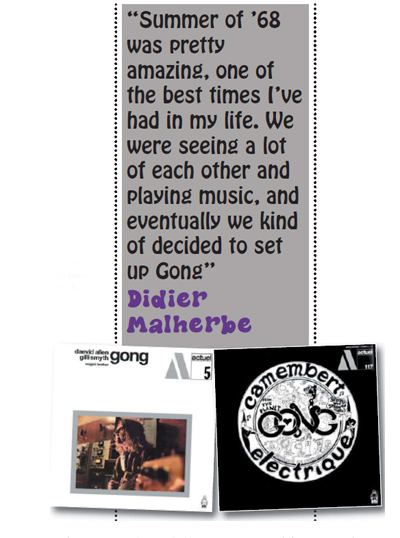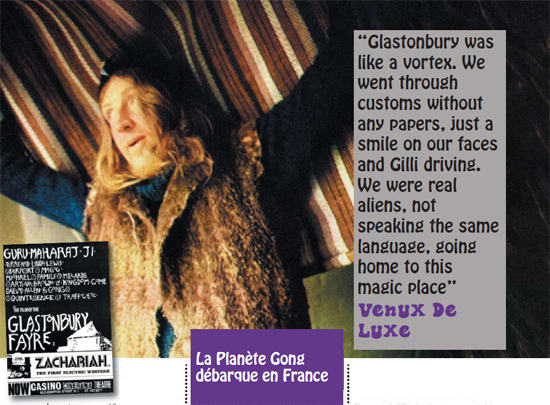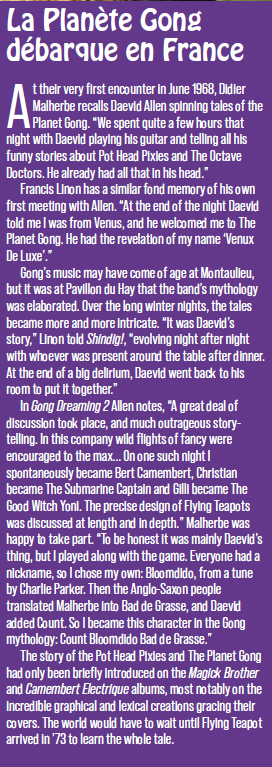| |
|
|
 An Austr-Alien in Paris - Shindig! - Issue 127 - May 2022 An Austr-Alien in Paris - Shindig! - Issue 127 - May 2022
oft Machine arrived in France at the beginning of July 1967 with a booking to play all summer long at
a “psychedelic discotheque” near St Tropez. When “all summer long” became “for three nights only”,
the band found themselves stranded in paradise with a truck full of gear and no money. However, a
chance beach-side encounter with a Parisian antique dealer would quickly turn things around. Bob
Benamou, who would soon become Gong’s manager, tells Shindig! “They were playing on the beach at a beer
festival; it was a horrible place and nobody was there. I said, ‘You can’t stay here,’ so I installed the whole
group in a villa in St Tropez. We became very close. Daevid Allen was so creative, so poetic, and so surrealistic:
an amazing person.”
Benamou was organising a series of
happenings with underground artist Jean-
Jacques Lebel. Lebel offered Soft Machine
the opportunity to perform during a
staging of Picasso’s play Desire Caught By
The Tail. The band leapt at the chance,
immersing themselves in the Dadaist
production for three weeks. Lebel told
writer Aymeric Leroy, “Daevid said to me
several times afterwards, and Kevin [Ayers]
too, that this experience had really allowed
them to ‘bloom’ as artists, to differentiate
themselves from what was around them.”
Soft Machine also scored an invitation
to play at a party organised by the owner
of Barclay Records, where they impressed
a large crowd of movers-and-shakers with
a 40-minute rendition of ‘We Did It
Again’. These performances created a buzz
among the Parisian artistic elite who’d
flocked to the Côte d’Azur that summer,
which gave the band a real foothold in
France. They would consolidate this
position by returning to the country every
month for the remainder of 1967.
|
Soft Machine in London just prior to Allen's enforced Paris sojourn.
L-R: Allen, Robert Wyatt, Mike Ratledge, Kevin Ayer
|
However, Soft Machine would make
these trips as a three-piece. An expired
visa saw Allen turned back at Dover, and
even worse, banned from entering the UK
for three years. Not wanting to return to
Australia, he had little choice but to install
himself in Paris. His time in Soft Machine
was brutally cut short.
Once in Paris, Allen leapt into action,
quickly gathering a collective of
improvising musicians around himself.
These included his long-term collaborator
and partner Gilli Smyth, vocalist Ziska
Baum and flautist Loren Standlee. For
their first show they took the name Gong
Full Moon Fantastickal, and soon landed a
10-week residency at underground hotspot
La Vieille Grille. Their sets of freely
improvised music caused a sensation in
Paris’s nascent underground scene. A long
segment filmed for French TV in early ’68
(available on YouTube) is revelatory,
showing the genesis of the idiosyncratic
styles that Allen and Smyth would later
perfect in Gong.
Allen has always given Syd Barrett
credit for inspiring his “glissando” guitar
technique. In Gong Dreaming 1 he writes:
“I saw Syd playing a curious sort of slide
guitar with the Floyd at Ally Pally in ’67
and he looked rather embarrassed by it.
But out front it sounded spectacularly
Wagnerian! I was impressed.” Armed with
a box of antique gynaecological
instruments and a delay unit, Allen
learned to coax a galaxy of sound from his
Telecaster guitar. While Allen was able to
explain the origin of his style, he was at a
loss when it came to describing Smyth’s “space whisper” vocals. “It didn’t come
from any outside influence that I know of.
She just immediately began to sing like
that... Ziska Baum and Gilli were magical
together. The two of them just created
that style together out of thin air.”
Allen made many contacts at the Vieille
Grille, the most important being with the
young filmmaker Jérôme Laperrousaz. His
support would prove incredibly important
to Allen over the next few years. When
Allen told him he was looking to put
together a new group to play more
traditionally structured songs, the
filmmaker put him in touch with Marc
Blanc and Patrick Fontaine. They were
the rhythm section of a band whose
guitarist had just been called up for
national service, and as fate would have it
were already ardent fans of Soft Machine.
The trio clicked immediately, playing
their first gig together in January ’68.
Blanc told Shindig!, “We had just enough
time to rehearse two tracks [‘Why Are We
Sleeping’ and ‘We Did It Again’]. We
played three sets that were basically freakouts.
The audience was stunned, enjoying
it without realising it was Soft Machine’s
guitarist playing.” Allen christened the
new band Bananamoon. While it would
only play a score of gigs and record a
handful of demos that were unreleased until decades later, its impact on French
music would be enormous. It spawned the
bands Gong and Ame Son, and in
bringing the first flush of real psychedelia
to France, helped shape the country’s
emerging musical underground.
Laperrousaz worked on the TV
programme Bouton Rouge, and used his
influence to organise a spot for
Bananamoon. Arrangements were made
to meet in the Latin Quarter to shoot a
clip for their version of ‘Why Are We
Sleeping?’. The chosen day turned out to
be during the worst street fighting of the
May ’68 protests. The band arrived in
what looked like a war zone: hastily
erected barricades, burned-out vehicles,
and uprooted trees everywhere, and the
air electric with tension. Bravely or
foolishly, Laperrousaz leapt at the chance
to use this as his backdrop. “We were
filmed climbing the barricades with our
instruments, against a background of total
chaos”, recalls Fontaine. Filming
continued for the entire day, with
Laperrousaz truly pushing his luck at
times. Allen relates in Gong Dreaming 1 that with cameras in tow, “l wandered
down a block to find a menacing black
battle-truck full of super tough paracommandos.
From somewhere Jérôme
miraculously conjured up a large paper
bag full of toy teddy bears. So l danced up
to the wagon, and bowed to the stonefaced
paratroopers... ‘Les compliments de
Winnie le Pooh...’ l cried solemnly and
handed each of them a wee teddy bear.
Stern jawlines cracked open with
amazement and then delight. They’d all
abruptly turned into little boys. l left
behind a truckload of human laughter...”
The paras may have been left laughing,
but once news of this filmed escapade
reached the authorities, they were not
amused. Laperrousaz was dismissed from
his job, but worse potentially lay in store
for Allen. Informed that he was on an
arrest list of undesirable aliens, he and
Smyth fled France. They headed for Deya
on the island of Mallorca, with Blanc and
Fontaine following soon after. Fontaine
remembers these months spent together
on their island refuge as an extraordinary
time. Living in community, they grew
closer both personally and musically.
In their absence Laperrousaz worked to
gain the interest of several record labels,
and in December ’68 Bananamoon
clandestinely returned to Paris to record
demo tapes, which ultimately failed to
secure a signing. To evade the attention of
the Paris police, the band relocated to a
property owned by Bob Benamou in the
tiny town of Montaulieu, near Avignon –
a place that would also be significant in
Gong’s story. There Allen began writing
the songs that would form the core of his
Magick Brother album.
Unfortunately, Marc Blanc was finding
less inspiration in Allen’s new music.
When Blanc’s former guitarist returned
from the army in April ’69, it didn’t take
long for him to float the idea of starting a new band. Two months later Blanc and
Fontaine split amicably with Allen to
form Ame Son.
From this point things moved very
quickly. Within months both Ame Son
and Daevid Allen had signed to BYG
Records, recorded their debut albums, and
shared the stage at the legendary
Amougies Festival. Well before
Bananamoon split, Allen had nurtured the
vision of a different kind of band. Central
to his plan was a flute and sax player he
had encountered in Paris, and then, in a
bizarre twist of fate, met again in Deya
just weeks later. Didier Malherbe told Shindig!, “I went to spend the summer in
Deya and Daevid was there! Summer of
’68 was pretty amazing, one of the best
times I’ve had in my life. We were seeing a
lot of each other and playing music, and
eventually we kind of decided to set up
Gong… not immediately, it came little by
little.”
|
Bananamoon, Balearic Islands, 1968. L-R: Patrick Fontaine, Daevid Allen, Gilli Smyth, Marc Blanc. |
With an album to record for BYG,
Allen called on Malherbe, who would be
the one constant musician at his side for
the next five years. According to Bob
Benamou, “After Daevid, Didier
Malherbe was the most important person
in Gong: a great, great musician.”
Malherbe makes the point that Magick
Brother, recorded in September ’69, isn’t a
Gong record, but a Daevid Allen solo
album with guest musicians: himself, Gilli
Smyth, and drummer Rachid Houari –
who would all become members of Gong
– along with a number of American
jazzmen. The LP is a fine set of
psychedelic pop songs leavened with
flourishes of free-jazz. Most significant in
foreshadowing the sound of Gong-tocome
are the bookending tracks. ‘Mystic
Sister’ points towards the glissando
guitar/space whisper vocal passages of classic Gong, while ‘Cos You Got Green
Hair’ is a more earthy taster of the
floating stoned-ambient interludes of the
Radio Gnome Invisible trilogy.
Immediately after completing the
recording, the group was augmented with
bassist Christian Tritsch, violinists Gerry
Field and Dieter Gewissler, and the
wildcard figure of Daniel Laloux on
vocals, hunting horn, and marching drum.
This was the line-up that played at The
Amougies Festival in October ’69.
Because of Allen’s relationship with
BYG, the band had a feature slot at the
festival, headlining the Sunday night lineup
of French bands. However, a series of
delays and over-runs pushed their
appearance into the wee hours of Monday
morning. Gerry Field, who left the band
immediately after the festival, informs Shindig! they were billed as The Daevid
Allen Group, and he can’t recall the name
Gong being used during his tenure.
Malherbe relates that it was 5am when
they finally took the stage, and shock
tactics were needed to energise the fading
audience. “People were lying like corpses,
half asleep. Daniel Laloux was playing a
military drum from the Napoleonic
period. So Daniel pounded on his drum,
and recited a famous Victor Hugo poem
about Napoleon and Waterloo,which was
only a couple of kilometres from
Amougies.” The crowd responded
enthusiastically. The remainder of the set
featured songs from Magick Brother interspersed with a good deal of free
improvisation. In his review for Rock &
Folk Paul Alessandrini called it an
“indisputable success”, impressed by the
band’s perfect balance of “musical
delirium” and “devastating humour”.
Jérôme Laperrousaz had filmed the
festival, but the sound recording of Allen
and co’s performance proved unusable. To
recreate their music for the film, he
invited Gong (as they were now known)
to move into his family’s chateau in
Normandy. The band would stay there
for the next five months, rehearsing and
recording. The tapes from the “haunted
chateau” reveal Gong’s progression from a
psychedelic pop sound to a much harder
psych-rock featuring long passages of free
improvisation. By the time Magick Brother was released in March ’70, Gong’s music
had progressed far beyond it. In fact,
Allen is surprisingly dismissive of the
album in an early interview. “It doesn’t
represent the current group. It was a kind
of masturbation, or rather the result of
massive constipation. In short I relieved
myself.”
Only a month later Gong’s new sound
was revealed on the single ‘Garçon Ou
Fille’ which exhibited a new-found
aggression: an almost punk energy
courtesy of Allen’s fuzzed-out guitar and
violently delirious vocal. This was just
one side of the coin, though. The more
esoteric, improvisational aspect of the
band can be heard in a performance of
‘Dreaming It’ filmed at about the same time (and available on YouTube) which
brings Malherbe’s and Gewissler’s
contributions to the fore.
Surveying the band’s evolution for Rock
& Folk in ’71, Paul Alessandrini was
clearly biased towards this era’s divergent
but oddly cohesive melange of music. He
described it as “sonic madness, a kind of
violence, with so many original
components asserted to excess, without
any search for formal perfection”.
Alessandrini singled out Daniel Laloux,
praising his contribution to Gong’s
“comedic and derisive theatrical side”.
This first era would be closed when
Laloux and Gewissler both departed in
May ’70. Bob Benamou also highlighted
Laloux’s early contribution. “He didn’t stay
long, less than a year, but he was great,
completely surrealistic, a fantastic artist.”
Benamou had been installed as Gong’s
manager a few months earlier and offered
his property in Montaulieu as the band’s
home base for the summer. Before heading
there Gong spent two months in Paris,
rehearsing in the cellar below Benamou’s
antique shop.
The catalyst needed to accelerate Gong’s
development was discovered
just before they left Paris, in
the person of Francis Linon,
aka Venux De Luxe. Linon
admits to Shindig! that he
blagged his way into the
band. “Daevid told me they
were on their way to the
south and that he needed
people to help with the
equipment. Without any
knowledge at all on what
was required, I said, ‘I’m
the man you’re looking
for!’ and my whole life
suddenly changed.”
A few days later, he was in Montaulieu
with the rest of the band. “It was a typical
small village at the top of a hill, where the
road ends. Bob owned practically all of it.
Behind the village, on a plateau in the
wilderness, there was an ancient
sheepfold. The electricity had just been
connected. This is where we moved in
with the equipment. It took us more than
a week just to clean up the goat droppings
covering the floor. After putting rugs all
over, we put the gear in the middle and
around the walls some mattresses
separated by stretched fabric for a little
privacy. A stove in a corner, the toilets
outside, the bathroom in the river... The
Gong community was born.”
In the three months Gong spent there,
Montaulieu became their spiritual home.
It was there that communal living became
an essential part of their lives, and it was
there that Gong’s music made a quantum
leap; when Linon massaged their sound
through his effects processors, a truly
cosmic music emerged.
With winter approaching, life in the
sheepfold was becoming harder and
harder. After a year of nomadic
wanderings, Gong needed a permanent base. They found it at Pavillon du Hay, an
abandoned hunting lodge 120 km southeast
of Paris and supposedly discovered by
Gilli Smyth randomly placing her finger
on a map. This would be their home until
they quit France for the UK three years
later.
The passage across ‘70 had been a
formative year for Gong. They had honed
their idiosyncratic music style and
developed a strong community ethos.
They entered ’71 with only one seveninch
to their name, but with the
foundations laid for an incredible creative
explosion. The first fruit was Daevid
Allen’s sophomore solo record. Keen to
capitalise on Soft Machine’s fame, BYG
wanted Allen to record with some of his
former bandmates. With the end of his
three-year ban, Allen was finally free to
travel to the UK and do just that. In
February ’71 he recorded the Banana Moon LP with Robert Wyatt guesting on vocals
and drums. Other players on the session
included violinist Gerry Field from the
Amougies band and drummer Pip Pyle.
During the sessions Allen met a young
studio engineer who was experimenting
with a new EMS synthesiser.
“I met Daevid at Marquee Studios,” Tim Blake tells Shindig! “He was having
trouble finishing Banana Moon, so I helped
out with the mixing. Daevid invited me
to go back with him to France the next
day.” Blake relocated to Pavillon du Hay,
bringing his EMS synth with him. If all
had gone according to plan, Camembert
Electrique would have had a more
electronic edge, but a change in drummers
put a spanner in the works.
Rachid Houari’s wife had never felt at
ease in the Gong community, and he
finally made the decision to leave the band
in spring ’71. Allen called in Pip Pyle
from the Banana Moon sessions to take
over. Unfortunately, he and Blake had
history. “Pip and I knew each other, but I
don’t think we liked each other very
much!” Pyle particularly hated Blake’s
synthesiser, claiming that it sounded “like
a flock of deranged psychedelic
chaffinches”. He put his foot down, saying
it was either him or Blake. Exit Tim Blake
(at least for now).
Pyle’s first few months in Gong were a
baptism of fire. Continuing its creative
streak, the band entered the Chateau
d’Herouville studio – Elton John’s
“Honky Chateau” – in May
’71 to record two albums in
quick succession.
First up was the
soundtrack to Jerôme
Laperrousaz’s film
Continental Circus. For
Allen this was an
important opportunity to
pay Laperrousaz back for
his immense support. In Gong Dreaming 2 he writes,
“We went into the studio
clean and clear. With Pip
on drums and no rehearsal
whatsoever, we completed the
soundtrack/album in a series of perfect
first takes... recorded, overdubbed and
mixed in two days. Jérôme was
delighted.”
It was Francis Linon’s first experience in
a recording studio. “Everything was done
almost live, I was operating the echo
chambers like in a concert. Everything
went very quickly and everyone was
pleased with the result. What happiness!”
Gong were back in Herouville almost
immediately, backing poet Dashiel
Hedayat on his album Obsolete. Allen was a
fan of Hedayat’s poetry and was very
happy to provide the music for his songs
and poems. The album was completed in
another whirlwind two-day session and
has gone on to be recognised as a classic of
the French underground scene. While
these albums are overshadowed by
Camembert Electrique, they are both
essential parts of Gong’s discography. The
longer tracks gave the band the chance to
stretch out, showcasing the
improvisational power they had developed
– most notably on ‘Cielo Drive/17’ from
Obsolete and ‘Blues For Findlay
(instrumental)’ from Continental Circus.
With two albums under their belt, Gong entered
Herouville
studios yet again
in June ’71. This
was the main event: a 10-day session to
record their debut album. According to
Linon, they entered the studio primed to
bring the past 12 months to a
culmination. “The recording of
Camembert Electrique was the concretisation
of everything that happened before, the
perfect way of life at Montaulieu, and
Pavillon du Hay.” In Gong Dreaming 2
Allen writes, “The band was right on its
own cutting edge so the results were
satisfying. Within 10 days we had
completed the backing tracks and most
instrumental overdubs.”
There was a two-month gap before the
mixing sessions took place in September
’71. Allen recalled listening to the final
playback. “I felt a deep sense of
completion and I was very happy. For the
moment, we had already won. I had the
feeling that this album would be around
for a long time.” Between the two sessions
Allen had led the band across the channel
to play at the ’71 Glastonbury Festival, and
for him their first gig in England was also a
homecoming. Francis Linon’s account of
the event is striking. “Glastonbury was like
a vortex. No one could stop us doing it.
We went through customs without any
papers, just a smile on our faces and Gilli
driving. We were real aliens, not speaking
the same language, going home to this
magic place.” The band had just kicked off
their afternoon set when disaster seemed
to strike.” As soon as we started, in a climax going up, the generator broke
down.” This setback actually ended up
being a godsend.
Allen picks up the story in Gong
Dreaming 2. “By the time we resumed it
was that magic sunset time and we were
now in the glow of stage lights. We had
barely started when I looked up to see a
pied piper line of a thousand or so
dancing people snaking down the hill to
gather at the front of the stage cavorting
and rejoicing to the music of this odd
French band called Gong... This was the
kind of audience that Gong had been
created for, and the gathering awareness
of this was running both ways at once.
This was our English spiritual family.”
A certain Richard Branson was in the
audience that day, and very soon he
would be making overtures to the band.
Gong would continue to live in France for
some time, but their interplay with
England would increase. The next album
would be recorded at Virgin’s Manor
studio, and over time more English
musicians would be added to the line-up.
Gong would never lose its French
influence, but after Glastonbury it would
never be quite as strong. A new chapter
had begun.
Ian would like to thank Bob Benamou, Marc
Blanc, Patrick Fontaine, Didier Malherbe,
Gerry Field, Francis Linon, Tim Blake, and
Aymeric Leroy for their generous contributions.
Gong tour later this year and a box set is due soon.
For news visit planetgong.co.uk
|


